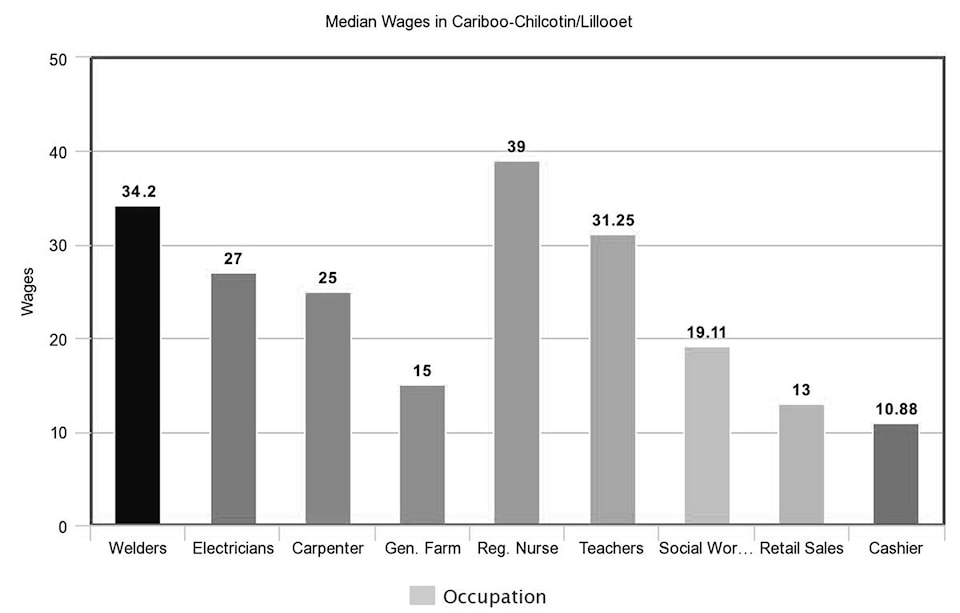The Northern Development Initiative Trust released their State of the North report on Jan. 9, providing a view of northern B.C.’s economic outlook.
“As the North’s economic development organization, it is important that we understand the data behind the decisions that are affecting the communities we serve. The State of the North report provides us with the economic context we need to better inform our own decisions, as well as those of our communities, businesses and non-profits so that together we can build a strong north,” said Joel McKay, CEO of the Trust.
The region (described by the trust as Lytton to the Yukon border and Valemount to Haida Gwaii) still heavily depends on the forestry, oil and gas, mining and agriculture industries as employers. The communities in this area are also dependent on business tax revenues. Of the municipal property tax base, 57 per cent of it is commercial and industrial, reflecting the area’s dependence on the resource industries.
The province’s GDP has risen to 3 per cent annually since 2011 and the economy has stabilized after the commodity price collapse in 2014 and northern B.C. saw growth due to mining development, oil and gas exploration and improvements in the forest industry between 2011 and 2014, according to the report
Since 2014, however, the economy has taken a hit following declines in the aforementioned industries and saw delays and cancelled infrastructure projects like the Northern Gateway pipeline. Furthermore, because of the 2014 softwood lumber agreement with the U.S. and countervailing and anti-dumping duties set in April and June 2017, it’s expected there will be a decline in forestry, says the report.
But there is a positive on the economic front. Mining and oil and gas exploration activity are expected to increase in the future. Two mines have reopened and employment in the sector has gone up in 2016. The Blackjack Gold Mine near Iskut is estimated to employ around 500 workers. The largest employers were the northeast, employing 4,800 people. Cariboo-Chilcotin/Lillooet saw an upward trend in the sector as well with 2,500 people after only having 1,900 in 2015.
Forestry production has risen in recent years due to high demand from China and the U.S. housing market rebounding and has seen a rise in employment since 2012. Timber processing facilities across the board haven’t seen much change, with two lumber mills opening since 2011, rising to 50 in total. A ninth pellet mill was also built between 2011 and 2015, but two of ten veneer, plywood and panel mills have closed.
Harvest volumes have also shown an upward trend with roughly 20 million cubic metres being harvested in 2015 and 2016, opposed to the totals collected between 2012-14, each year totalling between 16 million and 18 million.
The strongest growth, according to the report, is the Cariboo-Chilcotin/Lillooet region. The Northwest has also seen increases in wood product manufacturing employment.
The 3,633 agricultural businesses only account for one percent of employment in northern BC. It supports many agricultural related businesses however such farming equipment retailers, gravel, peat and feed suppliers and others, the report notes.
Most farms are small-scale family-run operations and don’t have employees but may hire temporary or seasonal workers.
The Cariboo-Chilcotin area has the second most farms (919), only behind the Northeast (1,359). However, the former has the most livestock farms with 606. The remainder (313) are crop farms mostly used to feed the livestock.
The number of farms in Cariboo-Chilcotin/Lillooet and northern B.C. has declined since 2011. The forestry industry, while overall has forecasted to be positive, has also taken some hits with the mountain pine beetle. On a positive note, mines are still operating in the area.
Employment in the Cariboo-Chilcotin area is mostly in the service-producing sector with 68.8 per cent and 31.2 per cent in the goods sector. However, the trust’s research reported a modest decline in employment since 2014, according to the report. Cariboo has an unemployment rate of 7.4.
Overall, unemployment rates in northern B.C. have been rising since 2014. This is consistent with mine closures and lack of activity in the oil and gas industry. Construction of infrastructure projects has offset the rates, with 2,600 people employed for the Site C project as of June 2017 which is expected to increase to 3,500, according to the report.
The four-phase Cariboo Connector on Highway 97 project also helps in this area, despite the third phase yet to be planned.
The population has remained relatively the same since 2011 but Cariboo-Chilcotin/Lillooet has an older population compared to the rest of the northern half of British Columbia. Over 20 per cent of the population is over 65 and there are relatively fewer working-aged people.
Between 2011 and 2016, businesses have seen a small increase in employees mostly in the construction, accommodation and food industry. However, roughly 90 per cent of businesses in the area have fewer than 20 employees and 55 per cent have less than five.
The living wages in the area are below the rest of northern B.C. ranging from Quesnel’s average of $16.39 to 100 Mile House’s $17.45 for the Cariboo-Chilcotin/Lillooet region.
House affordability is in a good spot, according to the report. In Williams Lake and Quesnel, roughly 27 per cent of household income goes into house ownership, while in 100 Mile House it is 32 per cent.
